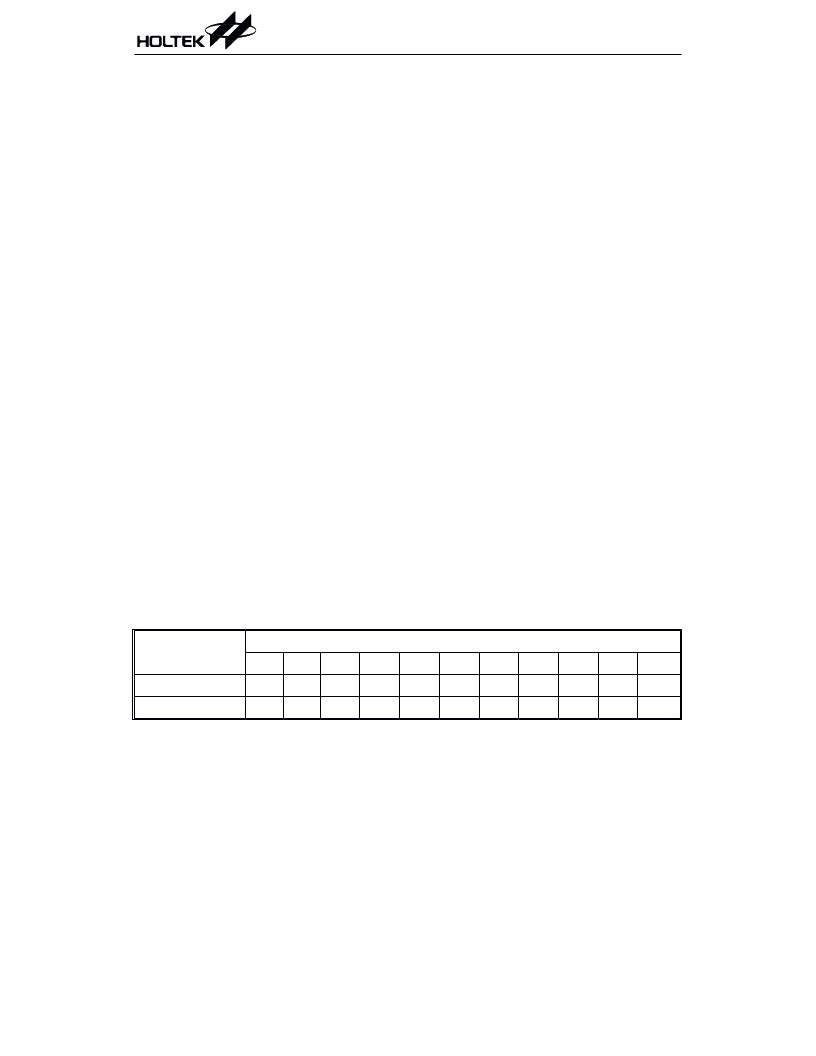- 您現(xiàn)在的位置:買賣IC網(wǎng) > PDF目錄385399 > HT46R47 (Holtek Semiconductor Inc.) 8-Bit OTP Battery Charger Controller PDF資料下載
參數(shù)資料
| 型號(hào): | HT46R47 |
| 廠商: | Holtek Semiconductor Inc. |
| 英文描述: | 8-Bit OTP Battery Charger Controller |
| 中文描述: | 8位檢察官電池充電器控制器 |
| 文件頁數(shù): | 8/45頁 |
| 文件大小: | 588K |
| 代理商: | HT46R47 |
第1頁第2頁第3頁第4頁第5頁第6頁第7頁當(dāng)前第8頁第9頁第10頁第11頁第12頁第13頁第14頁第15頁第16頁第17頁第18頁第19頁第20頁第21頁第22頁第23頁第24頁第25頁第26頁第27頁第28頁第29頁第30頁第31頁第32頁第33頁第34頁第35頁第36頁第37頁第38頁第39頁第40頁第41頁第42頁第43頁第44頁第45頁

HT46R47
Rev. 1.40
8
July 18, 2001
Instruction
Table Location
*10
*9
*8
*7
*6
*5
*4
*3
*2
*1
*0
TABRDC [m]
P10
P9
P8
@7
@6
@5
@4
@3
@2
@1
@0
TABRDL [m]
1
1
1
@7
@6
@5
@4
@3
@2
@1
@0
Table location
Note: *10~*0: Table location bits
P10~P8: Current program counter bits
@7~@0: Table pointer bits
well-defined, the other bits of the table word
are transferred to the lower portion of TBLH,
and the remaining 2 bits are read as "0". The
Table Higher-order byte register (TBLH) is
read only. The table pointer (TBLP) is a
read/write register (07H), which indicates the
table location. Before accessing the table, the
location must be placed in TBLP. The TBLH
is read only and cannot be restored. If the
main routine and the ISR (Interrupt Service
Routine) both employ the table read instruc-
tion, the contents of the TBLH in the main
routine are likely to be changed by the table
read instruction used in the ISR. Errors can
occur. In other words, using the table read in-
struction in the main routine and the ISR si-
multaneously should be avoided. However, if
the table read instruction has to be applied in
both the main routine and the ISR, the inter-
rupt is supposed to be disabled prior to the ta-
ble read instruction. It will not be enabled
until the TBLH has been backed up. All table
relatedinstructionsrequiretwocyclestocom-
plete the operation. These areas may function
as normal program memory depending upon
the requirements.
Stack register
STACK
This is a special part of the memory which is
used to save the contents of the program coun-
ter (PC) only. The stack is organized into 6 lev-
els and is neither part of the data nor part of the
program space, and is neither readable nor
writeable. The activated level is indexed by the
stack pointer (SP) and is neither readable nor
writeable. At a subroutine call or interrupt ac-
knowledgment, the contents of the program
counter are pushed onto the stack. At the end of
a subroutine or an interrupt routine, signaled
by a return instruction (RET or RETI), the pro-
gram counter is restored to its previous value
from the stack. After a chip reset, the SP will
point to the top of the stack.
If the stack is full and a non-masked interrupt
takes place, the interrupt request flag will be
recorded but the acknowledgment will be inhib-
ited. When the stack pointer is decremented (by
RET or RETI), the interrupt will be serviced.
This feature prevents stack overflow allowing
the programmer to use the structure more eas-
ily. In a similar case, if the stack is full and a
"CALL" is subsequently executed, stack over-
flow occurs and the first entry will be lost (only
themostrecent6returnaddressesarestored).
Data memory
RAM
The data memory is designed with 85 8 bits.
The data memory is divided into two func-
tional groups: special function registers and
general purpose data memory (64 8). Most are
read/write, but some are read only.
The special function registers include the indi-
rect addressing register (00H), timer/event
counter (TMR;0DH), timer/event counter con-
trol register (TMRC;0EH), program counter
lower-order byte register (PCL;06H), memory
pointer register (MP;01H), accumulator
(ACC;05H), table pointer (TBLP;07H), table
higher-order byte register (TBLH;08H), status
register (STATUS;0AH), interrupt control reg-
ister (INTC;0BH), PWM data register
(PWM;1AH), the A/D result lower-order byte
register (ADRL;20H), the A/D result
higher-order byte register (ADRH;21H), the
A/D control register (ADCR;22H), the A/D
相關(guān)PDF資料 |
PDF描述 |
|---|---|
| HT46R65-100 | A/D with LCD Type 8-Bit MCU |
| HT46C65 | A/D with LCD Type 8-Bit MCU |
| HT46C65-100 | A/D with LCD Type 8-Bit MCU |
| HT46C65-52 | A/D with LCD Type 8-Bit MCU |
| HT46C65-56 | A/D with LCD Type 8-Bit MCU |
相關(guān)代理商/技術(shù)參數(shù) |
參數(shù)描述 |
|---|---|
| HT46R47(18DIP-A) | 制造商:未知廠家 制造商全稱:未知廠家 功能描述:Analog IC |
| HT46R47(18SOP-A) | 制造商:未知廠家 制造商全稱:未知廠家 功能描述:Analog IC |
| HT46R47E | 制造商:HOLTEK 制造商全稱:Holtek Semiconductor Inc 功能描述:Cost-Effective A/D Type 8-Bit MCU |
| HT46R47-H | 制造商:HOLTEK 制造商全稱:Holtek Semiconductor Inc 功能描述:Cost-Effective A/D Type 8-Bit OTP MCU |
| HT46R48 | 制造商:HOLTEK 制造商全稱:Holtek Semiconductor Inc 功能描述:Cost-Effective A/D Type 8-Bit OTP MCU |
發(fā)布緊急采購,3分鐘左右您將得到回復(fù)。